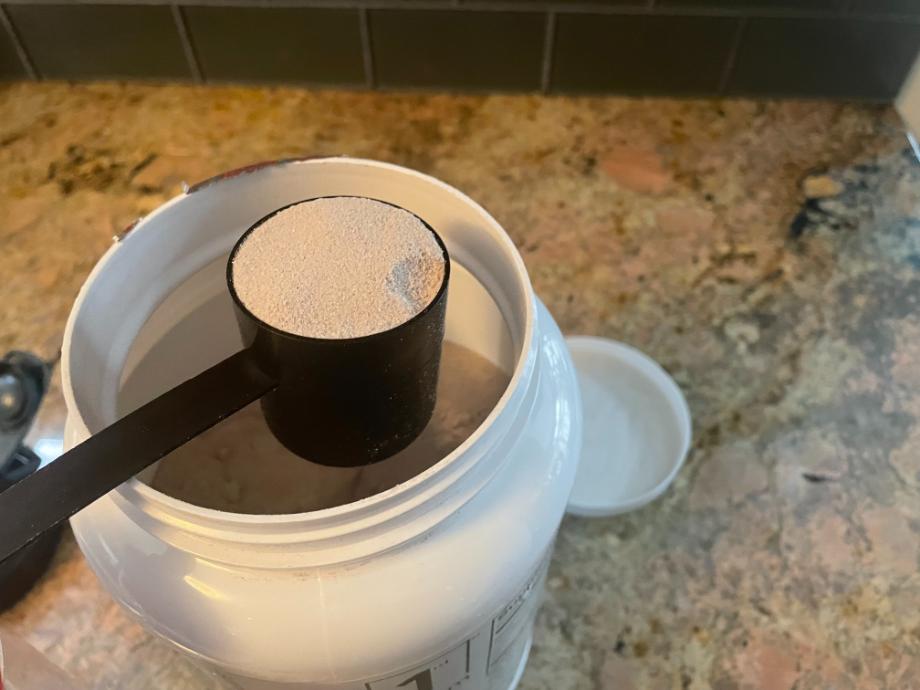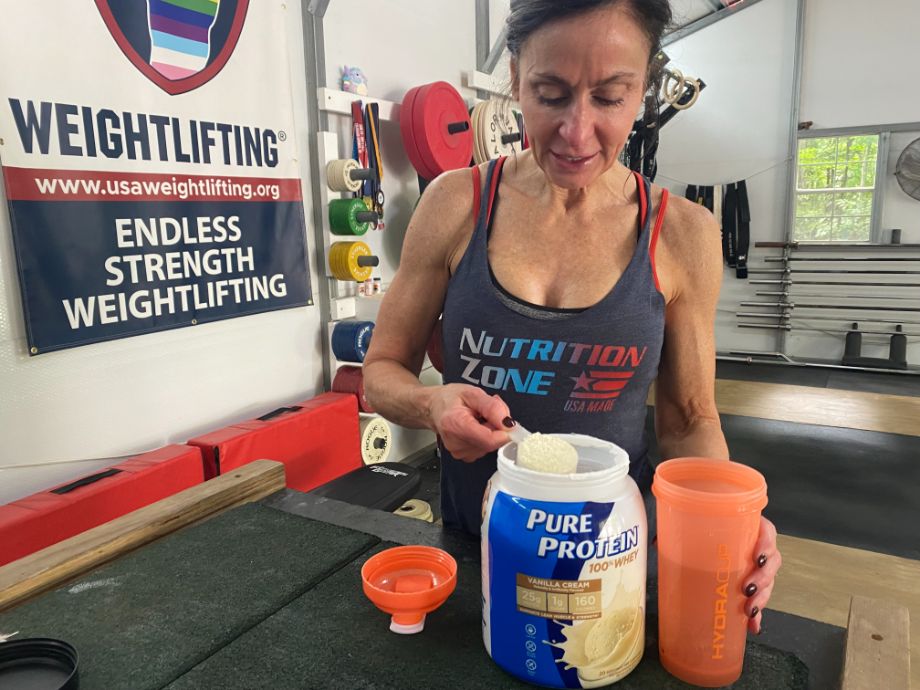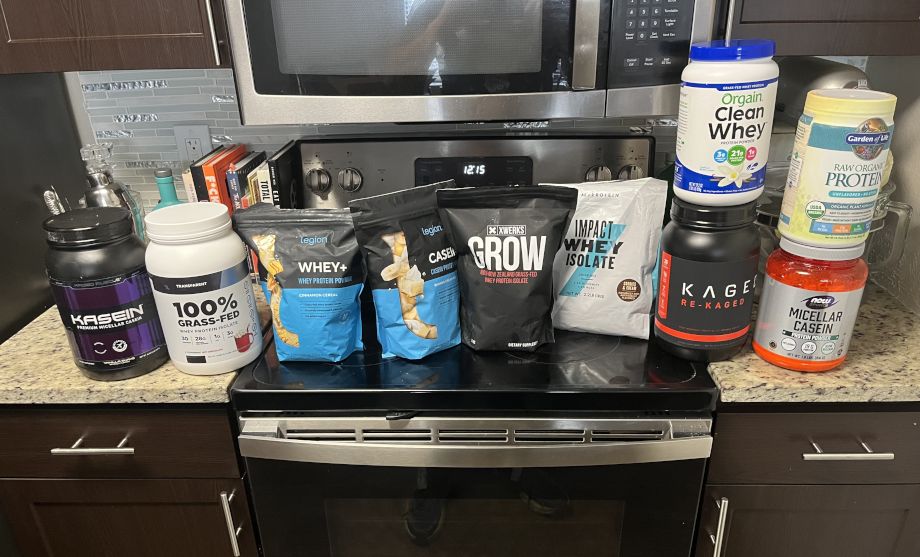Supplementing with whey protein satisfies more than just muscle gains for bodybuilders as it’s linked to several health benefits, including boosted immune system function, healthier aging, and a lower risk of developing chronic health problems.
For these reasons (and more), whey protein is one of the most popular dietary supplements in the fitness and wellness worlds. If you’re trying to consume more protein, a shake or other recipe with the best whey protein powder can add 20 to 25 grams of protein to your daily macros.
As a registered dietitian (RD), I’m here to show you how whey protein powder can benefit your health, plus tips for choosing and using whey.
Medical disclaimer: This article is intended for educational and informational purposes only. It is not intended as a substitute for medical advice. For health advice, contact a licensed healthcare provider.
What Is Whey Protein?
Whey protein has become synonymous with dietary protein supplements, but what is it, and where does it come from?
Whey protein is actually sourced from cow’s milk. It’s one of two types of protein found in milk, the other being casein protein. Both types of protein get extracted from milk then dried to create protein powder.

Whey is a byproduct of cheese production. When added to milk, the enzymes create casein by clumping into curds separate from the liquid portion. The remaining liquid is whey, which can then be dried to produce whey protein powder.
RELATED: How Is Protein Powder Made?
8 Whey Protein Benefits
Whey protein has been extensively researched for its effects on fitness, body composition, and general health. Here are my eight top health benefits of whey protein.
1. Complete Source of Protein
Whey protein is a complete protein1; it contains all nine essential amino acids (EAAs) your body can’t generate solo. The EAAs in whey are fast-digesting, meaning they travel through your system and get absorbed pretty quickly. That’s why whey is a popular choice for pre- and post-workout nutrition.
Whey protein is also a good source of branched-chain amino acids (BCAAs). It’s particularly high in leucine, a BCAA that studies have linked to increased muscle protein synthesis2. Out of all types of protein, studies have found whey protein has the most impact on muscle growth due to the rapid absorption of EAAs and BCAAs3.
2. Helps Muscles Grow
Many studies have found that taking whey protein before or after resistance training stimulates muscle growth. Most recently, a 2023 study4 compared two small groups of men following the same training program. At the end of four weeks, the group who took whey protein had more significant muscle gains than the placebo group. The men who took whey also had increases in strength and endurance during training compared to the control group.
Even if you’re not trying to get ripped or aiming for fat loss, increasing lean muscle mass supports healthy aging and boosts metabolism.
3. Improves Exercise Performance
As your muscles grow, they also get stronger. The more strength you have, the more power and endurance you can bring to your workouts to help you keep challenging yourself and achieving PRs.
The International Society of Sports Nutrition1 has reviewed existing studies on the effects of whey protein on exercise performance, concluding that regularly using protein supplements— like whey protein—positively affects resistance exercise performance, like weightlifting.
RELATED: Best Protein Powder For Muscle Gain
4. May Reduce Hunger and Cravings
Protein is a filling macronutrient that, when consumed regularly throughout the day, can help regulate hunger. Protein triggers the release of hormones that signal fullness (or satiety) and reduce appetite.

In a 2019 study5, participants who consumed a whey protein shake reported increased fullness and decreased appetite within about 30 minutes of drinking it. The satiating effect lasted for about two hours.
Whey protein can help create a satiating meal replacement shake or be used between meals to reduce hunger. You’re less likely to overeat and crave snacks when you feel full.
5. Supports Weight Loss
Whey protein’s effects on lean mass and satiety make it a natural choice to support weight loss. A 2022 meta-analysis6 reviewed the results from 35 studies on whey protein and body composition and found whey protein helps improve body mass index and waist circumference and supports reductions in body fat.
6. Supports Heart Health
A 2018 review7 of existing studies found whey protein improves several markers of heart health, including blood pressure, blood cholesterol, and blood sugar levels. Increased body weight and waist circumference are also markers of heart health.
As mentioned above, whey can improve these body composition markers to help lower your risk of developing heart disease.
7. Supports Healthier Aging
Consuming more protein and engaging in resistance exercise are proven methods for reducing the natural muscle loss or bone loss associated with aging—sarcopenia and osteoporosis, respectively.

However, you need more than just whey protein to support muscle mass and strength. A 2021 study8 found that adults over 65 who took whey protein and did heavy resistance training gained more muscle and strength compared with adults only taking whey. A 2023 review9 also found whey protein supplementation helps increase muscle mass in older people when combined with exercise.
Prioritizing protein intake and strength-building exercises earlier in life can help set the stage for maintaining lean mass as you age. The more muscle you have, the easier it’ll be to keep active and to do the things you love well into your golden years.
8. Contains Immune Supporting Nutrients
Whey contains several bioactive substances that support immune system function, including antioxidants, alpha-lactalbumin, and beta-lactoglobulin. Researchers have found these nutrients increase the production of immunoglobulins10, which are antibodies that help protect your body from allergens and illnesses.
Types of Whey Protein
There are three types of whey protein you’ll likely find when seeking protein supplements: whey protein concentrate, whey protein isolate, and hydrolyzed whey protein. They differ in how they’re manufactured and macronutrient profile.
RELATED: Types of Protein Powder
After the initial drying process, whey protein is considered intact. It contains all the original nutrients from that portion of milk, including carbohydrates, fat, and protein.

The dried whey is filtered to remove fat and carbs, which concentrates the protein content. The degree of filtration determines the type of whey protein.
Here’s a quick breakdown of each:
- Whey protein concentrate (WPC) contains more fat and carbs than other forms of whey and can range from 50% to 80% protein by weight.
- Whey protein isolate (WPI) has most or all of the fat and carbs filtered out and is 90% protein by weight or higher.
- Hydrolyzed whey protein, also called whey protein hydrolysate, is typically made from whey protein isolate and has a similar macro profile.
Research supports that all forms of whey protein offer health benefits, such as helping you gain muscle and strength. If you’re curious about which type of whey protein is best for your fitness goals, check out our article on whey protein isolate vs concentrate.
Possible Whey Protein Side Effects
Whey protein benefits health in numerous ways, but that doesn’t mean it’s the best choice for everyone. Since whey protein is a milk protein, it’s not a fit for vegans or individuals with a milk allergy. Vegetarians who consume dairy products can use whey protein.
If you’re sensitive to lactose or whey, whey protein can cause digestive upset. Symptoms include upset stomach, bloating, gas, and diarrhea. Those who have trouble digesting lactose may be at higher risk for experiencing whey protein side effects from using whey protein. Whey protein isolate contains less lactose than whey protein concentrate, so it may be easier to digest.
It’s worth mentioning that protein powders are dietary supplements and, therefore, not regulated by the Food and Drug Administration. Unfortunately, this means anything goes in terms of ingredients, and lesser-quality products may contain banned substances or harmful levels of contaminants, such as heavy metals.
There are a ton of protein powders on the market, and popular brands are subject to knock-offs. Choosing a third-party tested whey protein can help keep you safe and minimize the risk of consuming unwanted substances.
How to Take Whey Protein
As mentioned above, whey protein comes in concentrated, isolated, and hydrolyzed forms, so your first decision is: which is the best form for your needs?

You can easily find whey in powdered form, but ready-to-drink whey protein shakes and protein bars are also widely available. Whey protein powders are typically the most cost-effective option.
RELATED: How To Use Protein Powder
How To Make a Whey Protein Shake
Once you’ve decided on a whey protein powder, you’ll then have to consider how you want to prepare it.
Mixing a scoop of protein powder in water or milk is the most common way to consume whey protein, but whey protein powder is actually incredibly versatile. With all of the fun flavors out there, plus a little creativity, you’re not limited to protein shakes.
RELATED: Should You Mix Your Protein Shake with Milk or Water?
If you wish to increase your protein intake but keep your calories low, try mixing whey protein with water. If you have some wiggle room with your calories, dairy or plant-based milk—such as unsweetened almond milk—can make a creamier protein shake. You can also make a smoothie by blending your protein powder with frozen fruit, nut butter, or veggies.
Water may be the best choice if you’re taking whey protein post-workout and want to optimize the absorption of amino acids to support muscle recovery. Adding other ingredients, like milk or fruit, are tasty, but they add calories and macronutrients that can slow digestion and absorption of the protein.
You can also mix whey protein into yogurt or oatmeal, a cup of coffee (hello, salted caramel latte), and find a ton of recipes for protein pancakes, fudge, cookies, mug cakes, and more.
When To Take Whey Protein
Finally—and perhaps most debated—is when to take your whey protein.

You can have a whey shake before working out for extra energy or take it post-workout to refuel and jumpstart muscle recovery. However, the window for refueling and building muscle post-workout is estimated to last around 24 hours.
The latest consensus among experts is the timing of your protein doesn’t matter so much as just taking it.
Whey Protein Benefits: Final Thoughts
Whey protein supplements are well-researched and may help support several health and fitness goals. The most well-known benefits of supplementing with whey protein are lean muscle mass and strength increases when combined with strength training. Whey protein can also help satiate you between meals to support weight loss, help you retain muscle as you age, and support heart health.
Whey protein powders are affordable, convenient, and a source of high-quality protein. Whey protein will have the greatest effect on body composition and health when combined with regular exercise and a healthy diet.
If you can’t consume whey, there are alternatives to whey protein that offer similar benefits, including egg white protein and plant-based protein powders.
Whey Protein Benefits: FAQs
Is it good to drink whey protein every day?
Whey protein is considered a high-quality protein source, similar to meat and eggs. A daily whey protein shake counts as a serving of protein and can help you increase your total daily protein intake. Combined with resistance training, whey protein effectively supports muscle growth and strength.
What are the disadvantages of taking whey protein?
The primary disadvantage of whey protein is digestibility. While many people have no issues with whey protein, it can be difficult for others to digest. Signs of intolerance include upset stomach, bloating, gas, and diarrhea.
RELATED: Does Protein Powder Really Give You Protein Farts?
Weight gain can be another potential concern. Some whey proteins are high in sugar and calories. When adding whey to other ingredients, for example, a smoothie with fruit and milk, you could be taking in more calories than you’re using, resulting in weight gain.
When should whey protein be taken?
Most people believe taking their whey protein right before or after working out is best for muscle growth and recovery. However, researchers have found protein consumed within 24 hours of exercise is used to help muscles repair and grow.
So, the timing of your whey protein probably isn’t as crucial as just taking it. If you’re using whey protein to increase daily protein intake or gain weight, use it any time of day.
Can you have whey protein before bed?
You can take whey protein before bed, but casein protein is more popular for evening protein shakes and treats because it digests slower than whey, as it’s believed to help keep muscles “fed” for longer while you sleep. Whey may digest/absorb faster but still delivers essential amino acids to muscles.
Studies have found muscles are in repair and growth mode for about 24 hours after training11, so any protein taken during that time will support muscle health.
These statements have not been evaluated by the Food and Drug Administration. This product is not intended to diagnose, treat, cure, or prevent any diseases.
References
- Jäger R, Kerksick CM, Campbell BI, et al. International Society of Sports Nutrition Position Stand: protein and exercise. J Int Soc Sports Nutr. 2017;14:20. Published 2017 Jun 20. doi:10.1186/s12970-017-0177-8.
- Wolfe RR. Branched-chain amino acids and muscle protein synthesis in humans: myth or reality? J Int Soc Sports Nutr. 2017 Aug 22;14:30. doi: 10.1186/s12970-017-0184-9. PMID: 28852372; PMCID: PMC5568273.
- Park, S., Church, D.D., Azhar, G. et al. Anabolic response to essential amino acid plus whey protein composition is greater than whey protein alone in young healthy adults. J Int Soc Sports Nutr 17, 9 (2020). https://doi.org/10.1186/s12970-020-0340-5.
- Kim CB, Park JH, Park HS, Kim HJ, Park JJ. Effects of Whey Protein Supplement on 4-Week Resistance Exercise-Induced Improvements in Muscle Mass and Isokinetic Muscular Function under Dietary Control. Nutrients. 2023;15(4):1003. Published 2023 Feb 16. doi:10.3390/nu15041003
- Rigamonti AE, Leoncini R, Casnici C, et al. Whey Proteins Reduce Appetite, Stimulate Anorexigenic Gastrointestinal Peptides and Improve Glucometabolic Homeostasis in Young Obese Women. Nutrients. 2019;11(2):247. Published 2019 Jan 23. doi:10.3390/nu11020247
- Sepandi M, Samadi M, Shirvani H, et al. Effect of whey protein supplementation on weight and body composition indicators: A meta-analysis of randomized clinical trials. Clin Nutr ESPEN. 2022;50:74-83. doi:10.1016/j.clnesp.2022.05.020
- Wirunsawanya K, Upala S, Jaruvongvanich V, Sanguankeo A. Whey Protein Supplementation Improves Body Composition and Cardiovascular Risk Factors in Overweight and Obese Patients: A Systematic Review and Meta-Analysis. J Am Coll Nutr. 2018;37(1):60-70. doi:10.1080/07315724.2017.1344591
- Mertz KH, Reitelseder S, Bechshoeft R, et al. The effect of daily protein supplementation, with or without resistance training for 1 year, on muscle size, strength, and function in healthy older adults: A randomized controlled trial. Am J Clin Nutr. 2021;113(4):790-800. doi:10.1093/ajcn/nqaa372
- Cuyul-Vásquez I, Pezo-Navarrete J, Vargas-Arriagada C, et al. Effectiveness of Whey Protein Supplementation during Resistance Exercise Training on Skeletal Muscle Mass and Strength in Older People with Sarcopenia: A Systematic Review and Meta-Analysis. Nutrients. 2023;15(15):3424. Published 2023 Aug 2. doi:10.3390/nu15153424
- Ha DJ, Kim J, Kim S, Go GW, Whang KY. Dietary Whey Protein Supplementation Increases Immunoglobulin G Production by Affecting Helper T Cell Populations after Antigen Exposure. Foods. 2021;10(1):194. Published 2021 Jan 19. doi:10.3390/foods10010194
- McGlory C, Devries MC, Phillips SM. Skeletal muscle and resistance exercise training; the role of protein synthesis in recovery and remodeling. J Appl Physiol (1985). 2017 Mar 1;122(3):541-548. doi: 10.1152/japplphysiol.00613.2016. Epub 2016 Oct 14. PMID: 27742803; PMCID: PMC5401959.






